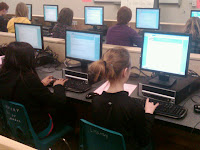One of the most peculiar buzz-phrases of the day in public education is "student-centered learning". It puzzles me that this seems to be a revelation. If I walked up to Joan Q. Public on the street who didn't work in the field of education and asked her a question like "What do you think about the exciting movement of the current system of education toward "student-centered learning?", I am quite confident that a quizzical look would pass over the person’s face, and they would respond with something like "If it isn't centered on students, what IS it focused on?". It would not be a huge stretch of the imagination that people who send their children to schools of today and pay taxes to fund our education system have the basic expectation that the focus of schools should be (GASP!) students. I believe they are right. Students (and their parents) are our clients, and we are here to serve them. Yet oftentimes, these very clients are overlooked in terms of the valuable input and feedback they can provide us about our schools.
 |
| Students using their "voice"! |
This week, we made major strides in our effort to involve students and parents in the development of our 2011-2013 School Improvement Plan. With the help of our School Planning Council (with students, parents and teachers as members), we developed a survey using Google forms. Our goal was to get as much input as we could about the structures that exist in our school, how they are utilized by students, what effective lessons looked like, how we could communicate with them best, and how we could make the entire experience at our school better for our clients—the students. The advantages of using Google forms were that we got real-time data to make sure that we were getting a representative sample of our school (we surveyed 640 of our 1450 students—more to come), and that the results were immediate and easily presentable to our School Coordinators and staff. Furthermore, we took the responses from numerous open-ended questions (which are often difficult to find commonalities from in large-scale surveys) and plugged them into Wordle to create word clouds. These word clouds gave us a quick and visual way to get a sense of some of the trends in the responses that we got from our students. (Check out this Effective Lesson Wordle of what students said about an effective lesson!) The results of our student survey will help to focus the discussions that our staff will have in developing our school improvement plan so that it is centered on STUDENTS and how we can make their high school experience meaningful and valuable.
We can be “student-centered”. What a concept!
No comments:
Post a Comment
Thanks for taking the time to comment on my blog!